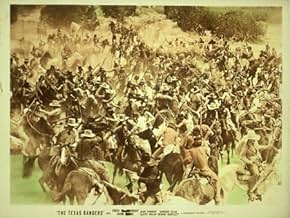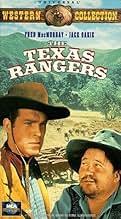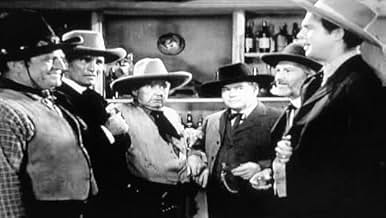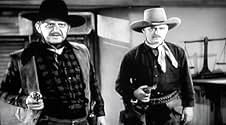IMDb-BEWERTUNG
6,5/10
881
IHRE BEWERTUNG
Füge eine Handlung in deiner Sprache hinzuTwo down-on-their-luck former outlaws volunteer to be Texas Rangers and find themselves assigned to bring in an old friend, now a notorious outlaw.Two down-on-their-luck former outlaws volunteer to be Texas Rangers and find themselves assigned to bring in an old friend, now a notorious outlaw.Two down-on-their-luck former outlaws volunteer to be Texas Rangers and find themselves assigned to bring in an old friend, now a notorious outlaw.
- Für 1 Oscar nominiert
- 1 Nominierung insgesamt
Benny Bartlett
- David
- (as Bennie Bartlett)
Fred Kohler
- Jess Higgins
- (as Fred Kohler Sr.)
George 'Gabby' Hayes
- Judge Snow
- (as George Hayes)
Stanley Andrews
- First Higgins Henchman
- (Nicht genannt)
Irving Bacon
- David's Father
- (Nicht genannt)
Kathryn Bates
- School Teacher
- (Nicht genannt)
John Beck
- Stage Passenger
- (Nicht genannt)
Hank Bell
- Hank Wallace, Texas Ranger
- (Nicht genannt)
Virginia Brissac
- David's Mother
- (Nicht genannt)
Empfohlene Bewertungen
This to me is a magical western of the straightforward "goodies in white hats, baddies in black" genre. It has style, humour and excitement and should be compulsory viewing for every 12 year old and above.
The Texas Rangers is directed by King Vidor who also co-writes with Elizabeth Hill, Louis Stevens and Walter Prescott Webb. It stars Fred MacMurray, Jack Oakie, Jean Parker and Lloyd Nolan. Music is by Gerard Carbonara and cinematography by Edward Cronjager. Plot has MacMurray and Oakie as two outlaws who decide to become Texas Rangers, something which invariably brings them into conflict with another outlaw pal.
It showcases the good and bad of 1930s Westerns. The action is strong and vibrant, the landscapes appealing and the story as a premise is always interesting. But those good points are countered with weak scripting, goofs, logic holes and a mixed bag of acting performances. But all told, Vidor's movie comes through its problems to stay firmly on the good side of good for the Western fan.
It's good guys versus bad guys on the home front, with the Indians lining up in numbers to be the common foe. It's here for the latter, where Vidor excels, constructing the action scenes with great skill as a ream of extras in Indian attire attack in their droves, arrows and bullets fly with murderous worth, bodies hurl and fall about, it's exciting stuff. The highlight coming as the Indians start flinging boulders off of a cliff face down onto the Rangers down below; the sound work here especially great, as is the stunt work in this whole segment of the film.
MacMurray and Oakie make a likable pair, but both seem a touch out of place in this portion of the Wild West. But Nolan cuts a nice snarly figure as chief villain Sam "Polka Dot" McGee, and he gets to deliver the film's best (nastiest) moment. Parker is pretty but pretty much a token, while secondary support slots are capably filled by the likes of Edward Ellis, Benny Bartlett and Frank Shannon. Cronjager's black and white photography is on the money, neatly utilising the New Mexico locations as wide open vistas that impose on the characters. While Carbonara scores it with standard Cowboys and Indian flavours for the attacks, and bombastic machismo for the Texas Rangers patrols.
Full of formula and mixed signals as to what it wants to be, The Texas Rangers is none the less an enjoyable picture and one of the better Oaters from the 30s. 7/10
Footnote: A sequel followed in 1940 called The Texas Rangers Ride Again. In 1949 The Texas Rangers was remade as Streets of Laredo, with William Holden starring.
It showcases the good and bad of 1930s Westerns. The action is strong and vibrant, the landscapes appealing and the story as a premise is always interesting. But those good points are countered with weak scripting, goofs, logic holes and a mixed bag of acting performances. But all told, Vidor's movie comes through its problems to stay firmly on the good side of good for the Western fan.
It's good guys versus bad guys on the home front, with the Indians lining up in numbers to be the common foe. It's here for the latter, where Vidor excels, constructing the action scenes with great skill as a ream of extras in Indian attire attack in their droves, arrows and bullets fly with murderous worth, bodies hurl and fall about, it's exciting stuff. The highlight coming as the Indians start flinging boulders off of a cliff face down onto the Rangers down below; the sound work here especially great, as is the stunt work in this whole segment of the film.
MacMurray and Oakie make a likable pair, but both seem a touch out of place in this portion of the Wild West. But Nolan cuts a nice snarly figure as chief villain Sam "Polka Dot" McGee, and he gets to deliver the film's best (nastiest) moment. Parker is pretty but pretty much a token, while secondary support slots are capably filled by the likes of Edward Ellis, Benny Bartlett and Frank Shannon. Cronjager's black and white photography is on the money, neatly utilising the New Mexico locations as wide open vistas that impose on the characters. While Carbonara scores it with standard Cowboys and Indian flavours for the attacks, and bombastic machismo for the Texas Rangers patrols.
Full of formula and mixed signals as to what it wants to be, The Texas Rangers is none the less an enjoyable picture and one of the better Oaters from the 30s. 7/10
Footnote: A sequel followed in 1940 called The Texas Rangers Ride Again. In 1949 The Texas Rangers was remade as Streets of Laredo, with William Holden starring.
On a whim, bandits Fred MacMurray and Jack Oakie enlist in the Texas Rangers. The two partner up with old pal Lloyd Nolan for some crooked schemes, but soon hear the call of duty, putting them at odds with their criminal lifestyle.
Like his most famous film, The Champ, director King Vidor imbues this with depression-era sensibilities and sentimentality, having lovable bums MacMurray and Oakie find self-respect, romance, and a sense of selflessness, all with a young orphan in tow.
Photography, direction, and action sequences are all first rate. The performances were a little dated, but adequate. Unlike others, I didn't find Oakie's good-old-boy character annoying or unrealistic.
Cameo appearances by George "Gabby" Hayes and Charles Middleton (Ming the Merciless) were a lot of fun too.
Like his most famous film, The Champ, director King Vidor imbues this with depression-era sensibilities and sentimentality, having lovable bums MacMurray and Oakie find self-respect, romance, and a sense of selflessness, all with a young orphan in tow.
Photography, direction, and action sequences are all first rate. The performances were a little dated, but adequate. Unlike others, I didn't find Oakie's good-old-boy character annoying or unrealistic.
Cameo appearances by George "Gabby" Hayes and Charles Middleton (Ming the Merciless) were a lot of fun too.
"The Texas Rangers" tells the story of three pals (Fred MacMurray, Jack Oakie, Lloyd Nolan) who are living the lives of outlaws until they become separated when cornered by a posse. MacMurray and Oakie wind up joining the Texas Rangers while Nolan becomes the notorious "Polka Dot Bandit". Eventually you know that the two sides will have the inevitable showdown. Great action scenes involving an Indian attack highlight the film.
A very young clean-shaven MacMurray is good in the lead and Jack Oakie is..well Jack Oakie as MacMurray's trusty sidekick. Nolan is fittingly evil as the grinning villain of the piece. Heroine Jean Parker plays MacMurray's love interest who convinces him of the error of his ways.
In the courtroom scene, watch for "B" western favorites George "Gabby" Hayes as a judge, Fred Kohlor as the town boss and Charles (Ming the Merciless) Middleton as his lawyer.
If the story seems familiar, it was remade as "The Streets of Laredo" in 1949 with William Holden, William Bendix and Macdonald Carey in the MacMurray, Oakie and Nolan roles respectively.
A very young clean-shaven MacMurray is good in the lead and Jack Oakie is..well Jack Oakie as MacMurray's trusty sidekick. Nolan is fittingly evil as the grinning villain of the piece. Heroine Jean Parker plays MacMurray's love interest who convinces him of the error of his ways.
In the courtroom scene, watch for "B" western favorites George "Gabby" Hayes as a judge, Fred Kohlor as the town boss and Charles (Ming the Merciless) Middleton as his lawyer.
If the story seems familiar, it was remade as "The Streets of Laredo" in 1949 with William Holden, William Bendix and Macdonald Carey in the MacMurray, Oakie and Nolan roles respectively.
The Texas Rangers (1936)
Routine. There are elements here of Westerns earlier (there were hundreds of obscure ones) and Westerns later (including some well known ones), with stagecoach holdups and cowboy and Indian battles (the Indians lose again) and with pioneer justice. All of the above, plus a man reluctant to see the love of a lonely and lovely woman out on the edge of nowhere.
In a sense, it isn't worth watching if you have other Westerns up your sleeve. But--there has to be a but--the plot is interesting because it turns upside down more times than a tumbleweed, the filming (with Cronjager behind the camera) is straight up and strong, and we get an early look at unlikely Wild West hero, Fred MacMurray. For those who like Westerns, this is a decent mid-30s example, before the explosion of greater examples in 1939.
The title is exactly what the movie is about on the surface--the ragtag but well supported Texas lawmen known as the Texas Rangers (legendary enough to not only have a more recent widely panned movie about them made starring Ashton Kushner but also a Baseball Team). It almost is a promo piece for the group, with a voice-over in the beginning like those FBI films of the 1950s. MacMurray is actually a bandit, teamed up with a kind of goofy second lead, Jack Oakey. In fact, it seems like a comedy at first, and the lightweight air never quite lets up.
It does get more serious, though, not only about love (briefly) but about the honor and ability of the Rangers to fight not only Indians but outlaws. MacMurray gets in the middle of a major mess because he plays both sides of the game, as outlaw and newbie Texas Ranger. Lloyd Nolan enters the plot after awhile and is a great outlaw of his own. It's hard to take MacMurray seriously in this rough rough world, but the music pumps it up and the scenery is dramatic and he holds his own well enough for a middling movie.
And it's a bit long. Even if the plot seems to demand two hours with more and more twists, it loses something of velocity as it goes. King Vidor directed a number of notable silents in the 20s, and a few great 30s films (including the black and white parts of the Wizard of Oz). This one shows the solidity of a great director, and the wobbly backbone of a so-so script.
Routine. There are elements here of Westerns earlier (there were hundreds of obscure ones) and Westerns later (including some well known ones), with stagecoach holdups and cowboy and Indian battles (the Indians lose again) and with pioneer justice. All of the above, plus a man reluctant to see the love of a lonely and lovely woman out on the edge of nowhere.
In a sense, it isn't worth watching if you have other Westerns up your sleeve. But--there has to be a but--the plot is interesting because it turns upside down more times than a tumbleweed, the filming (with Cronjager behind the camera) is straight up and strong, and we get an early look at unlikely Wild West hero, Fred MacMurray. For those who like Westerns, this is a decent mid-30s example, before the explosion of greater examples in 1939.
The title is exactly what the movie is about on the surface--the ragtag but well supported Texas lawmen known as the Texas Rangers (legendary enough to not only have a more recent widely panned movie about them made starring Ashton Kushner but also a Baseball Team). It almost is a promo piece for the group, with a voice-over in the beginning like those FBI films of the 1950s. MacMurray is actually a bandit, teamed up with a kind of goofy second lead, Jack Oakey. In fact, it seems like a comedy at first, and the lightweight air never quite lets up.
It does get more serious, though, not only about love (briefly) but about the honor and ability of the Rangers to fight not only Indians but outlaws. MacMurray gets in the middle of a major mess because he plays both sides of the game, as outlaw and newbie Texas Ranger. Lloyd Nolan enters the plot after awhile and is a great outlaw of his own. It's hard to take MacMurray seriously in this rough rough world, but the music pumps it up and the scenery is dramatic and he holds his own well enough for a middling movie.
And it's a bit long. Even if the plot seems to demand two hours with more and more twists, it loses something of velocity as it goes. King Vidor directed a number of notable silents in the 20s, and a few great 30s films (including the black and white parts of the Wizard of Oz). This one shows the solidity of a great director, and the wobbly backbone of a so-so script.
Wusstest du schon
- WissenswertesKing Vidor made this movie to honor the celebrations of the centennial of the state of Texas.
- PatzerHawkins and the other Rangers are surrounded by Indians. He kills the 2 Indians rolling rocks, throwing his empty pistol at one. As he descends the other side, he mounts a bareback horse, riding off shooting a pistol that shouldn't be there as he rides away.
- Zitate
Wahoo Jones: How do you expect to find Sam down in this country? Texas! Phooey! No towns, no ranch houses, no gals, no nuthin'. Hah! We can't see a jack rabbit in two days. Boy, you can't tell me we're still in the United States!
- VerbindungenEdited into Texas Rangers Ride Again (1940)
Top-Auswahl
Melde dich zum Bewerten an und greife auf die Watchlist für personalisierte Empfehlungen zu.
Details
- Laufzeit1 Stunde 38 Minuten
- Farbe
- Seitenverhältnis
- 1.37 : 1
Zu dieser Seite beitragen
Bearbeitung vorschlagen oder fehlenden Inhalt hinzufügen

Oberste Lücke
By what name was Grenzpolizei Texas (1936) officially released in India in English?
Antwort

































